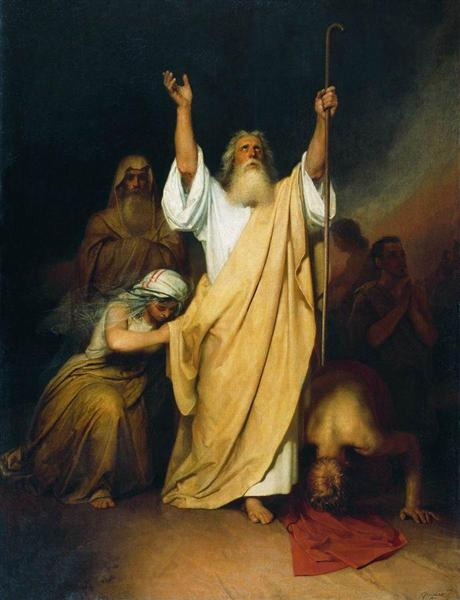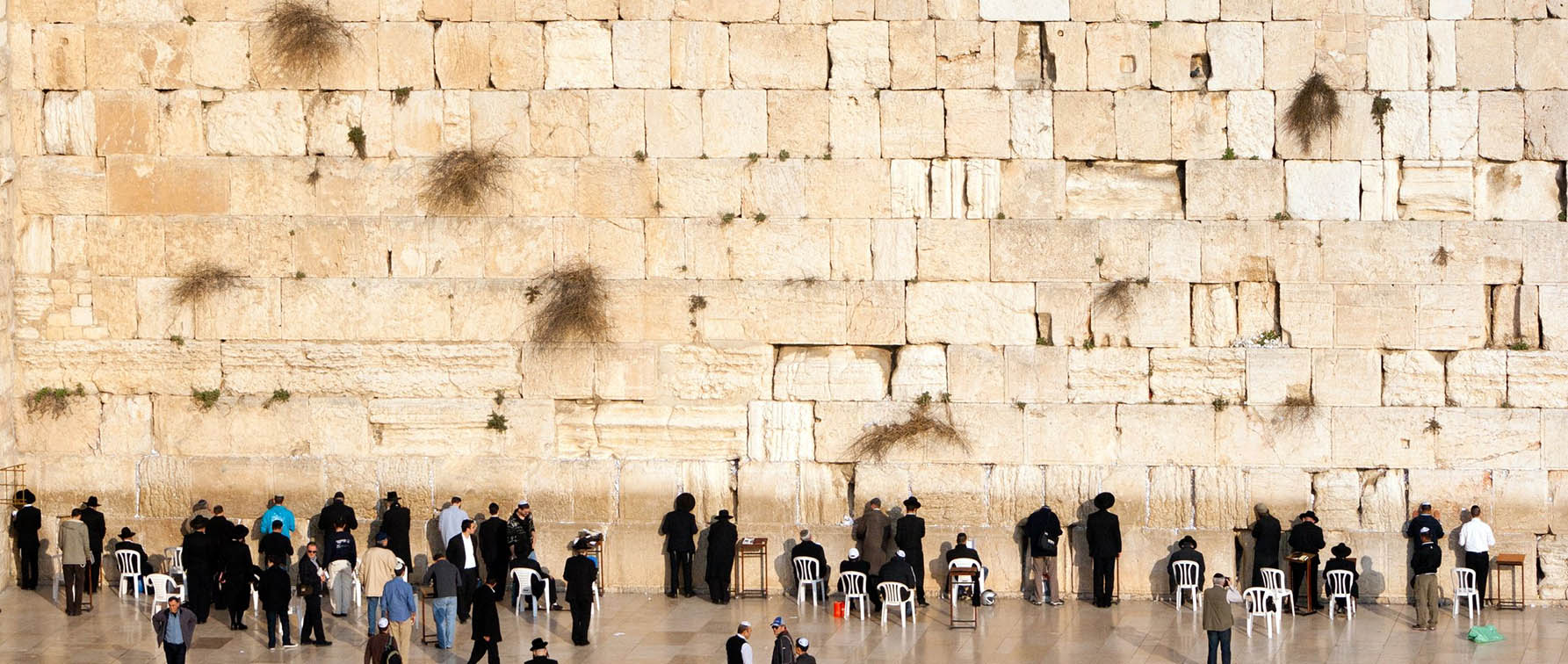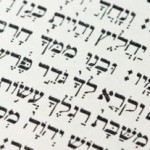“The prayer of the upright pleases Him.” (Proverbs 15:8)
Among those who know of God, but do not know Him, there is a misperception that He is remote, impersonal, and uninvolved in our daily lives.
But the Bible reveals that God created humankind for a very personal relationship with Him.
Prayer is a key way that we engage in that relationship and talk to Him. And it is a persistent theme throughout the Word of God.

A Jewish man prays in the Old City of Jerusalem at the Western (Wailing) Wall (also called the Kotel) with his tallit (prayer shawl) pulled over his head.
In the Garden, God met with Adam and Eve in the cool of the day where they could spend time together, sharing thoughts and feelings, similar to the way a good father makes time for his children as the day winds down. (Genesis 3:8)
This is a good time for a father to discover what kind of a day his children have had. If they have problems, he can share his wisdom and provide help or offer a solution.
Just as good children are interested in spending time with their parents and benefiting from their wisdom, God’s children should be spending time with their Heavenly Father.
Of course, He already knows what is on our minds even before we say, share, or ask anything.
He knows all things, but His openness to spend time with us, listening to our prayer is born out of His love and desire to have a real and vibrant relationship with us. He is ready to listen and to guide us, but we must first come to the Source of Life.
“For the eyes of the Lord are on the righteous and His ears are attentive to their prayer.” (1 Peter 3:12)

A father and son place prayers into the Kotel (Wailing Wall) in Jerusalem. It is estimated that over a million such prayers are placed in the Wall each year.
The past two decades have seen a surge of interest in the scientific community regarding the effects of prayer on healing.
In a survey of 41 observational clinical trials on private prayer and mental health conditions, researchers found that “frequent private prayer is associated with a significant benefit for depression, optimism, coping, and other mental health conditions such as anxiety.” (PubMed ID: 27452045)
In his Handbook of Religion and Health, Harold Koenig, MD, professor of psychiatry and behavioral sciences at Duke University, reviewed 1,200 studies on the effects of prayer and health.
Here are some statistics from these studies:
- Religious people in Israel had a 40% lower death rate from cardiovascular disease and cancer.
- Regular churchgoers have an average hospital stay of three times less than non-churchgoers.
- Heart patients who regularly participated in a religion were 14 times less likely to die following surgery.
- Elderly people who regularly attended church had strokes at half the rate of those who rarely or never attended church. (WebMD)
Jeff Levin, professor of epidemiology and population health at Baylor University found that 80% of Americans have prayed for their own healing (about 30% of those do so regularly). And 90% pray for others’ healing (half of those do so regularly).
“This might be one of the most prevalent forms of primary care medicine, and I don’t say that lightly,” he said. (CNN)
Although these studies were not necessarily measuring responses from Believers in Yeshua (Jesus), they do reveal that we were created with the desire and need to commune with God, even if many of us only consider it in times of distress.
What Is Prayer?
“He will call on me, and I will answer him; I will be with him in trouble, I will deliver him and honor him.” (Psalm 91:15)
Prayer is more than coming before God with a shopping list of requests that we wave in front of Him being before swiftly making our exit.
The Hebrew word for prayer is tefilah, which encompasses petition, but also worship, thanksgiving, praise, confession, and communing.
At the root of tefilah is the word palal, which means to think, to judge, to differentiate, to clarify, and to decide.
Prayer, therefore, is an introspective process that helps us examine ourselves, judge situations, differentiate between right and wrong, clarify our relationship with God, and decide on a course of action.
Our lives are filled with bewildering situations for which we must find answers and choose a proper course of action. This is not easy in the midst of the constant clamor of electronic devices that stream information and entertainment to us with the force and noise of an ocean.
To receive our Father’s wisdom, it is important to find a place where we can quiet our minds to hear His still small voice.
Only a regular pattern of prayer allows us to develop the ability to be in consistent communication with our Father in Heaven.tion.

Prayer of Moses after the Israelites Go through the Red Sea (1861), by Ivan Kramskoy (Source: Wikiart)
Prayer in the Bible
“And pray in the Spirit on all occasions with all kinds of prayers and requests. With this in mind, be alert and always keep on praying for all the Lord’s people.” (Ephesians 6:18)
The Bible is full of people who pray—and God answers them.
The first mention of individual, intercessory prayer is perhaps Abraham’s plea to save the city of Sodom (Genesis 18:23–32).
This prayer not only reveals that we can converse with God, it shows the influence a righteous person can have in the outcome of big events in cities or nations, including obtaining mercy in the outpouring of God’s judgment. (Genesis 18:23–32)
In Numbers 11:2, Moses prays to God for mercy on His people after their constant complaining causes God to set the outskirts of the camp on fire.
But God is also attentive to personal needs. In Genesis 24:12–14, Abraham’s servant, while on a mission to find a wife for Isaac, petitions God for clarity on which of the pretty maidens he should choose.
He asks God to perform a sign through Isaac’s future wife: she would offer him water to drink and also water his camels. God answers that prayer through Rebekah.
Later, in Genesis 25:21, Isaac cries out to God on behalf of Rebekah who was childless. God answers his prayer, and she becomes pregnant with Jacob and Esau.
In 1 Samuel 1, Hannah prays for a child, despite her apparent barrenness and pre-dedicates him to the Lord. God sees her heart and gives her a son even though Eli the priest mistakes her silent praying as drunkenness.
The Bible also records the petitions of leaders.
In 1 Samuel 8:6, the prophet Samuel prays to the Lord when the people demanded a king to rule over them, instead of God. (1 Samuel 8:6–8)
In 2 Samuel 7:18–29, David asks God to confirm the establishment of the house of David to rule over Israel. In 1 Kings 3:6–9, Solomon prays for wisdom when he receives the throne from his father David. That prayer includes the request for discernment: “an understanding heart to judge Your people to discern between good and evil.”
Many prayers in the Bible concern crying out to God in times of trouble. In Genesis 32:9–12, Jacob prays for protection when reuniting with his brother Esau.
In Psalm 86, David turns to God for support and strength when he is in distress.

Hiding out in the natural fortress, caves, waterfalls, and streams of Ein Gedi off the Dead Sea coast, David wrote some of his most poignant psalms while fleeing from King Saul.
Many psalms also record David’s crying out in repentance and confession.
In Psalm 51, David asks for God’s forgiveness (probably following the death of the man he murdered by his command) and includes the tender words: “Create in me a clean heart, O God, and renew a steadfast spirit within me.”
Daniel 9:4–19 relates Daniel’s prayer of repentance and his supplication and request in which he seeks God’s compassion upon the city of Jerusalem and, by extension, the exiled people of Judea.
And although many Believers avoid reciting prayers by rote, desiring sincere and original worship straight from the heart, Deuteronomy 26:5–10 may record the first standardized prayer in Judaism, not of petition but of praise and thanksgiving.
Moses dictated it for the people to recite before the priest when they presented the first fruits of the harvest.
The Lifestyle of Prayer
“Rejoice always, pray continually, give thanks in all circumstances; for this is God’s will for you in Yeshua HaMashiach (Jesus the Messiah).” (1 Thessalonians 5:16–18)
Prayer is meant to be an integral part of our lives, not something done once a week at the synagogue or assembly.
In Judaism, prayer is made continuously. The observant or Orthodox Jew is in constant contact with God through a pattern of prayer that precedes every act.
There are prayers of blessings on awakening, putting on the prayer shawl prior to the morning benedictions, following the use of the bathroom, for washing hands, for hearing bad news, etc.
There is even a prayer of blessing when drinking water.
There is a prayer said over bread before a meal followed by a long prayer Birkat HaMazon (Blessing over the Food) at the end of the meal.
Each short prayer of blessing said before eating begins with these words: “Blessed art Thou, oh Lord our God, King of the universe, Creator.”
The prayer for drinking wine or grape juice, for instance, is “Blessed art Thou, Lord our God, King of the universe, Who creates the fruit of the vine.”
It’s traditional to cover the head while praying, which explains why observant Jews keep their heads covered, wearing a kippah or skullcap, in order to pray constantly.
The three traditional daily services of the Jewish prayer book are Shacharit (morning), Mincha (afternoon), and Maariv (evening).
These correspond to the three sacrificial services offered up during Temple times.
The prayer book or Siddur consists of prayers offered during each of these three services, many of which are the same or similar such as the Amidah (Shmoneh Esreh, or Standing Prayer) or the 18 Benedictions.
(In fact, there are 19: the 12th benediction was added in the first century and is considered to be a condemnation of the Minim, Hebrew for sectarians or heretics, implying those who believe in Yeshua. It is thought to have been included to discourage Jewish Believers from attending synagogue services.)
Yeshua’s Example
“One day Yeshua was praying in a certain place. When He finished, one of His disciples said to Him, ‘Lord, teach us to pray, just as John taught his disciples.’” (Luke 11:1)
Consistent with the Jewish lifestyle of prayer is Yeshua’s devotion to the Father. He spent a lot of time praying: morning, day, and night. (Matthew 14:23; Mark 1:35)
“Yeshua often withdrew to lonely places and prayed.” (Luke 5:16)
Because prayer is such a continual part of the observant Jewish lifestyle, Yeshua’s disciples requested that He teach them to pray, the same way that Yochanan the Immerser (John the Baptist) had taught His talmidim (disciples).
Much of Yeshua’s teaching was in fact related to prayer. He wanted His talmidim to be in communication with the Heavenly Father as He was.
He warned them against using prayer as an outward demonstration of devotion. Such outward displays often have no inward spiritual substance. They can be designed to make a show of “holiness.”
“When you pray, you are not to be like the hypocrites; for they love to stand and pray in the synagogues and on the street corners so that they may be seen by men. Truly I say to you, they have their reward in full.” (Matthew 6:5)
Yeshua stressed the importance of spending time alone with God “in secret.”
He contrasted prayer arising from relationship with God to the pagan conception of repetitive prayer. This type of prayer uses beads and prayer wheels to repeat prayers numerous times as a kind of meditation. Although some think that this increases the strength of the prayer or one’s spirituality, He warned against using meaningless repetition to try to communicate with God.
Reminding them that the “Father knows what you need before you ask Him,” He emphasized that prayer is not just about saying words; it is about a relationship with the Living God. (Matthew 6:7–8)
Yeshua presented His disciples with what is now called “The Lord’s Prayer.” (Matthew 6:9–13)
This very Jewish prayer begins with “Our Father” and immediately moves to praise and reverence: Holy is Your Name; then to petition: “Your will be done.”
The beginning of the Lord’s Prayer—Our Father, in Hebrew, Avenu or simply Abba (Father)—is common in Jewish liturgy.
It appears in the Shemoneh Esreh, (the 18 Benedictions) in the fourth, fifth, and sixth benedictions, in the prayers recited for the New Year, and in the invocation “Our Father who art in heaven,” which is in common use as in “Yehi razon mi-lifne abinu she-bashamayim”—May it be thy will, our Father who is in Heaven.
Yeshua taught His disciples that prayer is about bending the knee to God’s will and not imposing our own will, although as we come into deeper relationship with God, absorbing His Word and understanding His character, we sincerely want God’s will to be done on earth as it is done in Heaven.
This is a statement of praise and trust: God is wise and moral. His will is upright, honorable, and loving.
The idea of God’s will being done on earth as in Heaven or the coming of His divine kingdom is also seen in the Kaddish (mourner’s prayer)—“and may He establish His Kingdom … speedily and at a near time.”
God is reliable, loving, and deeply concerned with our individual needs. Therefore, after praising God by recognizing His sovereignty in heaven and revering the holiness of His name (which signifies His character), we can request that our needs for the day be met.
Yeshua then emphasized prayer of confession and repentance: we ask God to forgive us our debts and sins as we forgive our debtors and those who sin against us. Receiving God’s forgiveness is connected to our willingness to forgive others.
“But if you do not forgive others, then your Father will not forgive your transgressions.” (Matthew 6:15)

The Meeting of Esau and Jacob, by James Tissot depict the forgiveness and reconciliation between two estranged brothers (Genesis 33).
Yeshua also instructed His disciples to request that we not be led into temptation but that we be delivered from the evil one. We are called to consecration, but we are surrounded by forces opposing it and drawing us away. We need God’s empowerment to live a holy life.
Although this prayer generally fits the Jewish pattern of praise, petition, and thanksgiving, the intent behind it is not to create a formulized prayer that cannot be personalized.
It does remind us that prayer is not just a shopping list, and that the Kingdom of Heaven is at hand.
It also provides guidance on key issues that we can incorporate into our conversations with God. Such heart-to-heart talks with God can cause the reality of His Kingdom to manifest in our lives, changing our environment and bringing us peace.
“Do not be anxious about anything, but in everything, by prayer and petition, with thanksgiving, present your requests to God. And the peace of God, which transcends all understanding, will guard your hearts and your minds in Yeshua HaMashiach.” (Philippians 4:6–7)

































